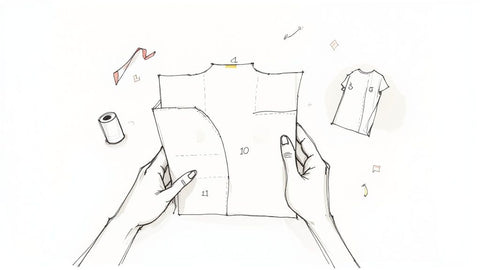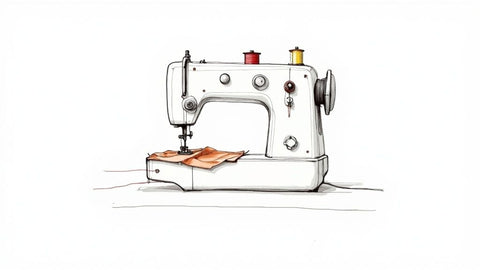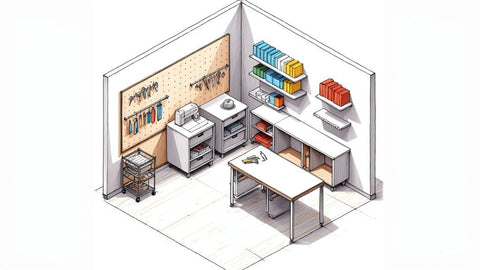Learning a new skill like sewing is such an exciting feeling, but let's be real—walking into the world of patterns can feel like trying to read a map in a foreign language. That's where beginner-friendly sewing patterns come in. Think of them as your personal guide, designed with simple shapes, just a few pieces, and clear instructions to help you build your confidence, not your frustration. This comprehensive how-to guide will show you tangible examples you can replicate, turning a pile of fabric into the pure joy of making something with your own two hands.
Starting Your Sewing Journey with Confidence
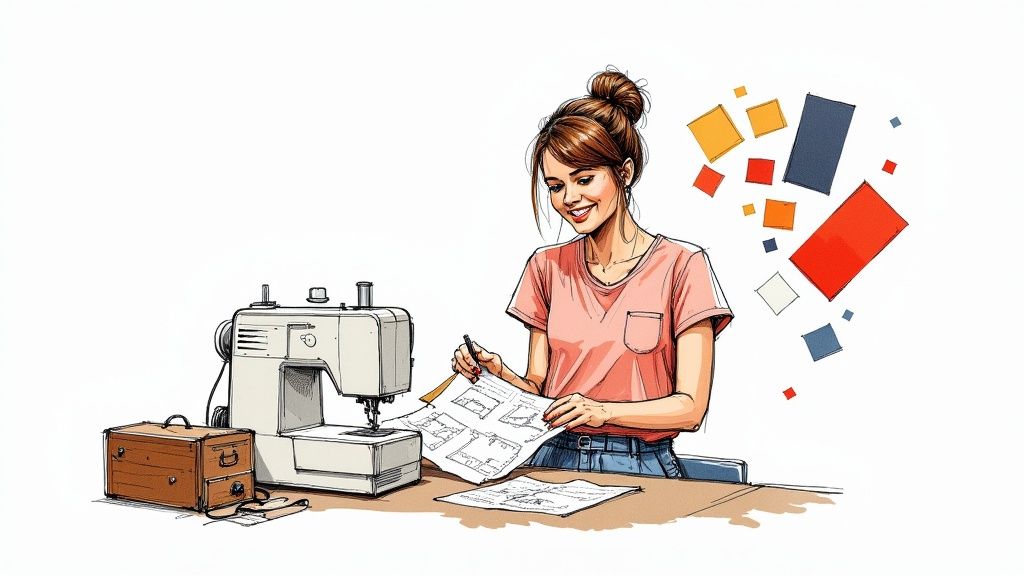
Diving into sewing is an adventure, but staring at that wall of patterns can be intimidating. The secret is to see your first pattern not as a test you can fail, but as a creative partner that’s on your side. A truly good beginner pattern is more than just "easy"—it's a teacher in an envelope, guiding you through the foundational skills without making you want to pull your hair out.
It’s a lot like learning to cook. You wouldn’t start with a five-course gourmet meal, right? You’d probably make scrambled eggs or a simple pasta dish—something that gives you a delicious, confidence-boosting win. Sewing is exactly the same.
The best patterns for someone just starting out are designed to make the process rewarding. They usually focus on a few key things:
- Forgiving Designs: These are patterns that look great even if your stitches aren't perfectly straight yet. Think simple tote bags, pajama pants, or A-line skirts.
- Clear Instructions: Good beginner patterns break everything down step-by-step and explain the sewing jargon as they go. No guesswork needed.
- Skill-Building Elements: Each project should teach you a core technique you'll use again and again, like sewing a straight seam, finishing an edge, or inserting simple elastic.
Here at bsewinn.com, we’re all about this supportive approach. We are committed to empowering crafters through our custom sewing machine designs, which are backed by extensive resources like online classes and training. We truly believe that with the right project and a little guidance, anyone can fall in love with sewing and have a partner in their corner.
Before you even cut your fabric, make sure you're set up for success by checking out the top sewing tools for beginners in our article. Having the right gear on hand makes all the difference. This guide is here to help you turn that initial hesitation into the absolute thrill of creating something that is uniquely yours.
What Makes a Sewing Pattern Easy for Beginners
Stepping into the world of sewing patterns can feel like trying to read a map in a foreign language. But figuring out what makes a pattern truly beginner-friendly is easier than you might think. Just like a recipe for a first-time baker, the best ones have simple ingredients, clear steps, and a result you can be proud of. A good beginner pattern is all about setting you up for a win, not a headache.
The heart of an easy pattern is its simplicity. Keep an eye out for designs with minimal pattern pieces. Honestly, a project with just three or four large pieces is so much more approachable than something with a dozen tiny, confusing shapes. This cuts down on your cutting time and drastically lowers the chances of mixing things up, letting you get right to the fun part: learning to sew.
Core Elements of a Beginner Pattern
Beyond just counting the pieces, the actual construction is what really matters. Beginner-friendly patterns almost always stick to simple, straight seams and gentle curves. They cleverly sidestep the tricky stuff that requires a lot of practice, like setting in sleeves, wrangling zippers, or fussing with complicated buttonholes. Instead, you'll find easy wins like elastic waistbands or simple tie closures.
Choosing the right first project is all about building that foundation of skill and confidence. The real goal is to finish something that makes you feel amazing—that's the feeling that will keep you coming back to your machine.
The fabric recommendation on the pattern envelope is another huge clue. Patterns made for beginners will point you toward stable, cooperative fabrics like cotton, flannel, or linen. These materials are a dream to work with because they don't slip and slide under the needle, unlike their slinky cousins, silk and chiffon.
This infographic really nails down what you should be looking for.
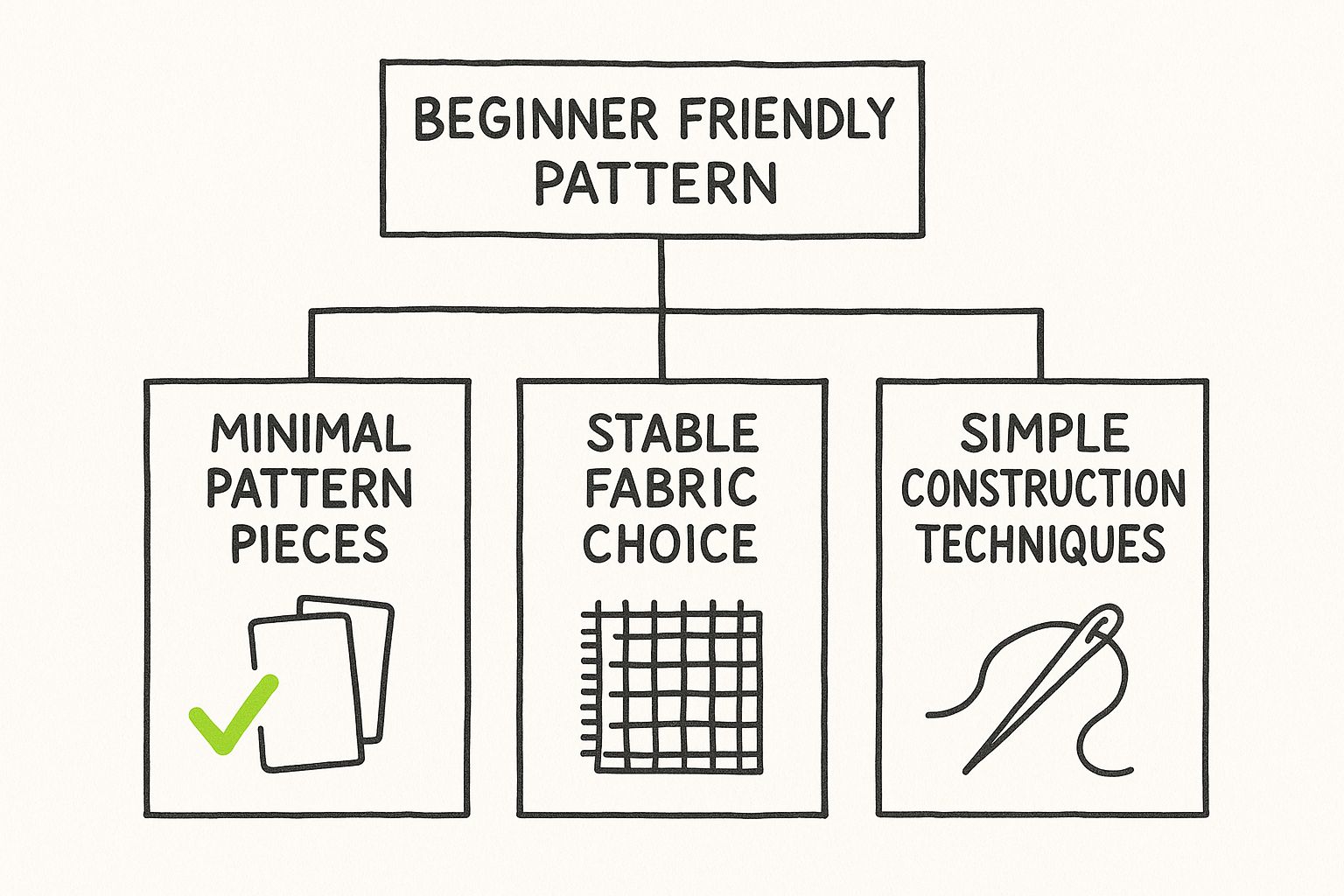
As you can see, a successful first project really comes down to those three pillars: few pieces, simple techniques, and easy-to-handle fabric.
To help you get started, here's a quick checklist you can use when you're browsing patterns.
Key Features of a Beginner Friendly Pattern
Use this checklist to identify the best patterns for your first sewing projects.
| Feature | Why It Matters for Beginners | What to Look For |
|---|---|---|
| Minimal Pattern Pieces | Fewer pieces mean less cutting, less confusion, and a faster path to a finished project. | Projects with 3-6 main pieces. Pajama pants, simple tote bags, or A-line skirts. |
| Simple Seams | Straight lines and gentle curves are much easier to control, helping you build confidence at the machine. | Look for designs without sharp corners, princess seams, or complex gussets. |
| Basic Closures | Avoids frustrating techniques like zippers or buttonholes that require precision and practice. | Patterns that use elastic waistbands, simple ties, or have a loose, pull-on fit. |
| Stable Fabric | Non-slippery fabrics are easier to cut accurately and won't shift while you sew. | Recommendations for quilting cotton, linen, flannel, or chambray. |
| Clear Instructions | Detailed, well-illustrated guides prevent guesswork and help you learn the right way from the start. | Look for patterns with diagrams or photos for each step and clear terminology. |
| No Complex Techniques | Starting simple allows you to master the fundamentals before moving on to more advanced skills. | Avoid patterns that mention darts, pleats, gathering, or set-in sleeves. |
By keeping these features in mind, you'll be able to spot the perfect pattern to kick off your sewing journey with confidence.
Many independent pattern designers and companies focus on these exact qualities, providing super clear instructions and stylish, approachable designs perfect for an afternoon project.
If you're still not sure what style will look good on you, playing around with virtual clothing try-on apps can be a fun way to visualize the final garment before you even cut your fabric.
How to Read a Sewing Pattern Envelope
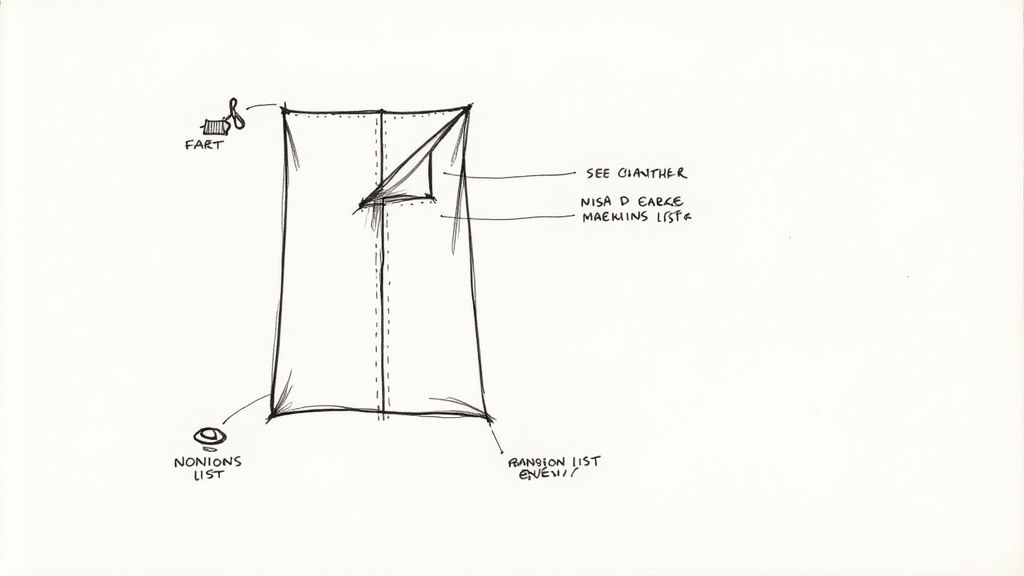
Walking into a fabric store and seeing walls of sewing patterns can feel a little intimidating. The envelope is your project's roadmap, but it's packed with so much information it's hard to know where to start.
Think of it like the back of a recipe card—it has all the critical info you need to get a great result. Once you learn how to read it, you'll be able to shop with confidence and know exactly what you need before you even get to the cutting table.
The front usually has pretty photos or drawings of the finished garment. You'll often see a few different versions, called "views," which are the variations you can make from that single pattern. The back, though, is where the real magic happens. It’s your shopping list and technical guide all rolled into one.
Decoding the Back Panel
This is where you'll find all the nitty-gritty details. Before you do anything else, you absolutely must know your measurements. Learning how to take body measurements for clothes is a game-changer. Don't just guess or use your store-bought clothing size—pattern sizing is a completely different world!
Once you have your numbers, the back of the envelope will tell you everything you need to know:
- Sizing Chart: This table is your best friend. It lists body measurements (like bust, waist, and hips) so you can pinpoint the exact size you need to cut.
- Fabric Recommendations: You'll find a list of suggested fabrics, like "cotton poplin" or "linen blends." For your first few projects, stick to these! The pattern was designed specifically for how these fabrics drape and stretch (or don't).
- Fabric Yardage: This handy chart tells you precisely how much fabric to buy. It's broken down by size and the width of the fabric bolt (usually 45" or 60"). Getting this right saves you from running out of fabric mid-project or buying way too much.
- Notions List: This is the "everything else" section. It'll list all the other bits and bobs you'll need, like matching thread, buttons, zippers, elastic, or interfacing.
Taking a few minutes to read the entire envelope before you buy anything is one of the best habits you can build. It ensures you walk out of the store with every single thing you need, turning a potentially frustrating start into a smooth, fun process.
Understanding these key pieces of information sets you up for success from the very beginning. If you're ready to get even more confident at the fabric counter, check out our guide on how to calculate fabric yardage.
Great First Projects to Build Your Skills
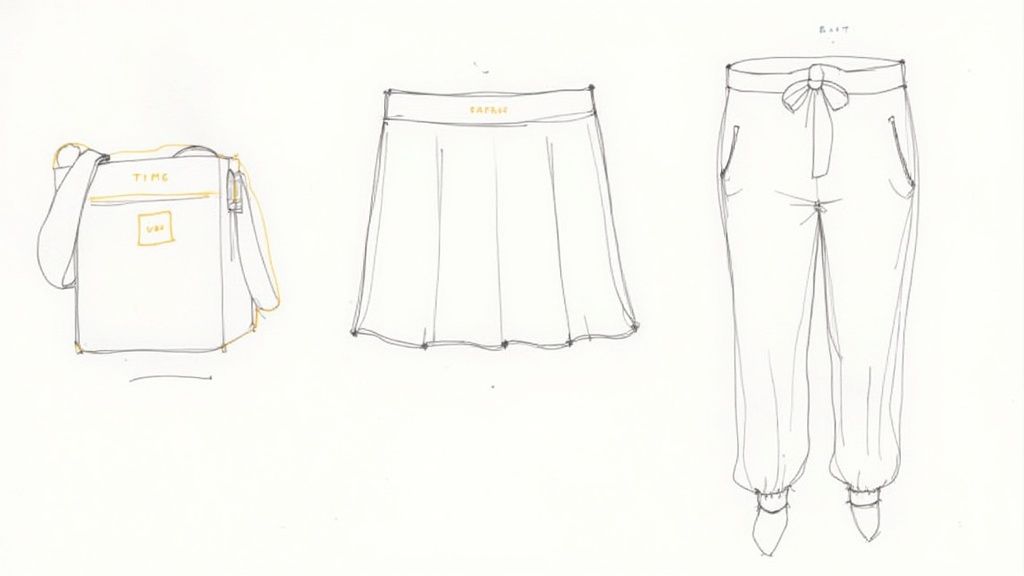
Alright, you’ve learned how to read a pattern envelope—now for the fun part! It’s time to actually choose what you’re going to make.
Picking your first project is a big deal. It’s not just about finding a style you like; it’s about choosing something that will teach you the core skills you’ll use for the rest of your sewing life. A good first project gives you a quick, satisfying win that makes you excited to keep going.
Think about classics like pajama pants, a simple tote bag, or an elastic-waist skirt. There's a reason these are the go-to tangible examples for new sewists! They teach you the absolute must-knows without throwing a bunch of complicated techniques at you all at once. Each one is like a mini-lesson that takes you from a flat piece of fabric to a finished item you can actually use.
For instance, making a tote bag is the perfect way to get the hang of sewing straight seams and reinforcing corners so they last. When you make a pair of pajama pants, you're really just learning how to make a simple casing for elastic—a skill you'll use in tons of comfy clothes. These projects are the real foundation of your entire sewing journey.
The best beginner friendly sewing patterns are the ones that leave you with something you're proud to show off. That feeling of accomplishment is the best motivation to pick up your next, slightly more challenging project.
Core Skills You Will Learn
- Pajama Pants: This project is all about sewing long, straight seams, creating a simple channel (or casing) for an elastic waistband, and getting the hang of a basic hem.
- Simple Tote Bag: You’ll totally master straight stitching, pivoting at corners, and how to securely attach handles.
- Elastic-Waist Skirt: A fantastic way to learn how to finish raw fabric edges, do a bit of light gathering, and pop in an elastic waistband for a comfy fit.
Here at bsewinn.com, we design our custom patterns and online training with these exact projects in mind. We want to guide you through these skill-building steps so your first creation is a huge success.
It's interesting to see how popular certain patterns get depending on the season. Come spring, you’ll see a huge spike in searches for dress patterns as everyone gets inspired to make something new for their wardrobe. Thanks to social media and online shops, it’s easier than ever for beginners to find patterns with really clear instructions. If you're curious, you can discover more insights about on-trend sewing patterns and how they shape what people are making.
Your Step-by-Step Guide to a First Project
Alright, you've got your pattern and your fabric. Now for the fun part: bringing it all together! This how-to guide will walk you through the prep work for a simple tote bag, a tangible example you can easily replicate. Believe it or not, some of the most critical steps happen before you ever touch the sewing machine pedal.
First things first: pre-wash your fabric. I know, I know, it's tempting to jump right in, but trust me on this one. Washing and drying your fabric exactly how you'll wash the finished tote is a non-negotiable step. It prevents that dreaded post-sewing shrinkage that can warp all your hard work. Do this, and your tote bag will keep its shape for years to come.
With your fabric prepped, it's time to decode your pattern. Those printed pages are covered in a secret language of symbols—lines, notches, and dots that are your map for where to cut, fold, and stitch. Learning to spot key markings, like the grainline arrow that shows how to align your pieces with the fabric's weave, is the secret to getting everything to fit together just right.
Prepping and Cutting Your Fabric
Now, you're ready to lay out your pattern pieces on the fabric. Your pattern instructions will have a layout diagram—it’s not just a suggestion! It's designed to save you fabric and keep everything properly aligned. Smooth out every wrinkle and pin those paper pieces down so they don't budge.
Grab your sharpest fabric shears or a rotary cutter and carefully cut out each piece. Take your time here. Precision is everything. When your pieces are cut accurately, they fit together like a puzzle, which makes the actual sewing part so much smoother and more enjoyable.
A great sewing project is built on careful preparation. Taking your time with pre-washing, understanding the pattern symbols, and cutting precisely is what separates a homemade item from a truly handmade one. This foundation of care builds confidence for every project you'll ever make.
One of the biggest anxieties for new sewists is getting that perfectly straight line of stitches. Here's the secret: guide the fabric, don't force it. And don't watch the needle! Instead, keep your eye on the edge of your fabric as it moves along the seam guide on your sewing machine's needle plate.
At bsewinn.com, we're all about empowering crafters with the right skills from the very beginning. Our custom sewing machine designs are supported by extensive resources, including online classes designed to guide you through these foundational steps. For a closer look at these techniques, feel free to explore our library of free sewing lessons to build your confidence.
Finishing that first project is such a rush, isn't it? That moment you hold up something you made from just a flat piece of fabric… that's the magic. Now that you've had a taste of what's possible, the real adventure begins.
You’ve built a solid foundation, and now it’s time to decide where you want to go. You could try a pattern with a simple pocket, or maybe dip your toes into the world of stretchy knit fabrics. It's all about building on what you already know without getting in over your head.
Time to Level Up Your Skills
My best advice? Add just one new skill per project. Seriously, just one. Maybe you pick a pattern that introduces you to gentle gathering, or one that has you sew your very first buttonhole. It's a fantastic way to grow your confidence step-by-step. At bsewinn.com, we are committed to helping you on that journey with our custom sewing machine designs, in-depth online classes, and all the resources you'll need.
Think of that first finished project as your passport. The skills you just learned are the entry stamp to a whole world of creativity—every single garment, quilt, or pillow you'll make from here on out will use them.
You’ve picked an amazing time to get into sewing. The interest in making your own clothes and crafts is exploding. In fact, the global market for sewing supplies, including beginner friendly sewing patterns, is expected to hit USD 7.81 billion by 2032. It’s all part of a bigger shift toward DIY fashion and making things that last. If you're curious, you can read the full research about the sewing supplies market and see just how much this community is growing.
We can't wait to see what you make next. Keep exploring, keep trying new things, and know that we're here to cheer you on every step of the way.
Common Questions About Sewing Patterns
It's completely normal to have a ton of questions when you're just starting out. Let's tackle a few of the most common ones I hear from new sewists.
What Is the Easiest Clothing Item to Sew for a Beginner?
Pajama pants or a simple elastic-waist skirt are fantastic first choices. I always recommend these because they're mostly straight seams and the construction is very straightforward.
You'll get to build those core skills and, most importantly, gain confidence without wrestling with tricky fittings or closures like zippers just yet.
Do I Need to Wash My Fabric Before I Start Sewing?
Absolutely. I can't stress this one enough. It is so important to pre-wash and dry your fabric exactly how you plan to care for the finished garment.
Think of it this way: fabric, especially natural fibers like cotton, can shrink quite a bit. This one simple step gets all that shrinking out of the way before you cut and sew, preventing your beautiful new creation from getting warped or too small after its first real wash. It also rinses out any chemicals from the manufacturing process.
Can I Use a Different Fabric Than the Pattern Recommends?
For your first few projects, it’s best to stick to the fabrics the pattern designer suggests. They’ve designed and tested that specific pattern with a certain fabric drape and weight in mind.
Swapping it out for something different can really change how the final piece fits and hangs on your body. Once you have a few successful projects under your belt, you'll get a better feel for which fabrics you can substitute.
At B-Sew Inn, our goal is to empower you at every single stage of your creative journey. We're here to help you sew with confidence, offering everything from custom sewing machine designs and online classes to a huge library of resources. Explore everything we have to offer you at https://www.bsewinn.com today.

